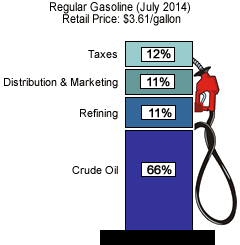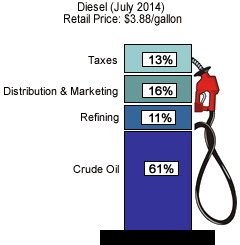 PetroStrategies, Inc. PetroStrategies, Inc. |
||||||||||||||||||||||||||||||||||||||||||||||||||||||||||||||||||||||||||||||||||||||||||||||||||||||||||||||||||
|
||||||||||||||||||||||||||||||||||||||||||||||||||||||||||||||||||||||||||||||||||||||||||||||||||||||||||||||||||
|
Gasoline Toolkit Why Does Gasoline Cost So Much?Gasoline is made by processing or refining crude oil. The cost of gasoline is shown in the following table:
Based on July 2014 economics.
For the latest updates, please see Gasoline and Diesel Fuel Update. The two largest cost components are crude oil and taxes which comprise about 84% of gasoline price. In the United States taxes include both a Federal and State tax. Both of these taxes are levied as cents/gallon rather than as a percent of price. State taxes can vary considerably depending on the need and philosophy of the local government. The price of crude oil, which is 58% of pump price in our example, is a large factor in determining pump prices and in causing prices to fluctuate. This relationship is illustrated in the plot of Gasoline and Crude Oil Prices.
4Go to the Topic Listing PetroStrategies analysis indicates that increases in average U.S. pump prices are explained by the average cost of crude oil processed in a U.S. refinery (Refiner's Acquisition Cost) and the average utilization of U.S. refining capacity. The formula used to make this forecast is based on historical data and has an R2 value of 0.9182. 4Go to the Topic Listing How Do I Calculate My Mileage? One of the best things that you can do is to make sure that your car is getting the best mileage possible. 4Go to the Topic Listing Stretching Your Gasoline Dollar
4Go to the Topic Listing Hunting for Low Gasoline Prices 8
4Go to the Topic Listing Before you start driving around town looking for the cheapest gasoline, calculate your savings compared to the costs of the extra mileage using the following calculator. 4Go to the Topic Listing Gasoline provides fuel for our mobile lifestyle in the United States. Unfortunately, the characteristics which make it a good fuel for car engines also make it a dangerous product. Gasoline is highly flammable (burns easily) and very volatile (evaporates quickly). Our familiarity with gasoline often makes us unaware of its dangers. The following cautions have been issued by fuel manufacturers and equipment providers. Smoking - Most people know not to smoke when fueling their car with gasoline. These dangers also apply when filling your weed eater, lawnmower, chain saw and any engine using gasoline as a fuel. Gasoline should not be used to clean hands or kill weeds. Buy products designed for these uses. It is also a good idea to only use approved containers to store gasoline, do not overfill the approved gasoline containers, make sure they are stable when transporting and store in a safe area away from flames and children. Cell Phones - The Shell Oil Company recently issued a warning after three incidents in which mobile phones (cell phones) ignited fumes during fueling operations. In the first case, the phone was placed on the car's trunk lid during fueling; it rang and the ensuing fire destroyed the car and the gasoline pump. In the second, an individual suffered severe burns to her face when fumes ignited as she answered a call while refueling her car. And in the third, an individual suffered burns to the thigh and groin as fumes ignited when the phone, which was in his pocket, rang while he was fueling his car. Cell phones can ignite fuel or fumes. Mobile phones that light up when switched on or when they ring release enough energy to provide a spark for ignition. Mobile phones should not be used in filling stations, or when fueling lawn mowers, boats, etc. Cell phones should not be used, or should be turned off, around other materials that generate flammable or explosive fumes or dust i.e. solvents, chemicals, gases, grain dust, etc. Static Electricity - Static electricity has been responsible for gasoline fires. Bob Renkes of Petroleum Equipment Institute is working on a campaign to try and make people aware of fires as a result of "static electricity" at gas pumps. His organization has researched 150 cases of these fires. There were 29 fires where the vehicle was reentered and the nozzle was touched during refueling from a variety of makes and models. Some resulting in extensive damage to the vehicle, to the station, and to the customer. Seventeen fires that occurred before, during or immediately after the gas cap was removed and before fueling began. Out of 150 cases, almost all of them were women! Almost all cases involved the person getting back in her vehicle while the nozzle was still pumping gas. The fire started from static electricity when the pump had shut off and she went back to pull the nozzle out. Most men don't get back in their vehicle until completely finished which is why they are seldom involved in these types of fires. Most had on rubber-soled shoes. Mr. Renkes stresses to never get back into your vehicle while filling it with gas. If you absolutely have to get in your vehicle while the gas is pumping, make sure you get out, close the door and touch the metal on the door frame, before you pull the nozzle out. This way the static from your body will be discharged before you ever remove the nozzle. Pat Cabling who works at Chevron Texaco's Richmond Refinery offered these four simple rules for safe fueling.
You might want to post these simple rules in your car so that everyone knows how to be safe when using fueling with gasoline. Explain these rules to the new drivers at home especially. According to an article on Snopes.com:
While this article questions the validity of the sources of gas station fires, it also confirms that static electricity can cause fires. The question seems to be in the data and research supporting cautions about cell phone use and reentering the car during fueling. In our mind, if you believe that static electricity can cause fires, then you should avoid potential sources of static electricity. This caution should apply to any devices that cause or could cause a spark including electrical appliances. We also question any multitasking that prevents complete attention to the task of filling the fuel tank. Spilling gasoline on your hands, clothes and car is certainly undesirable. You should also be aware of other motorists who may be careless during fueling (spilling gasoline or smoking) and this means focusing on the task at hand. Lastly, we would suggest that caution in handling volatile fuels may save you from a horrible consequence. (Source: Static Quo, Snopes.co) 4Go to the Topic Listing Here are some fueling tricks from a 31-year industry pro who works for Kinder-Morgan Pipeline in San Jose, CA.
4Go to the Topic Listing 4Go to the Topic Listing Copyright 2000
|
||||||||||||||||||||||||||||||||||||||||||||||||||||||||||||||||||||||||||||||||||||||||||||||||||||||||||||||||||


